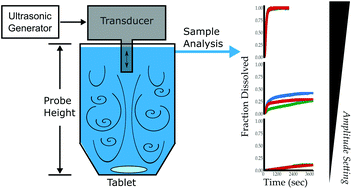Small volume method for drug release screening using ultrasonic agitation
Abstract
Drug release testing plays a major role along all parts of the dosage form development and manufacturing process. However, official methods to perform this type of testing are often resource intensive and require highly specialized facilities. Affordable and accessible methods for studying drug release behavior are currently lacking. This work presents a small volume approach to solid dissolution and drug release testing of solid dosage forms using ultrasonic agitation. Cavitation and acoustic streaming were generated by a microprobe horn delivering a 40 kHz acoustic signal into a 50 mL test vessel. These two phenomena resulted in breakdown of and release of drug from tablet samples. Prednisone Performance Verification Tablets were used as model tablets to study the effect of system parameters on the drug release process. The effects of these parameters on the acousto-hydrodynamic environment were studied using streak photography and hydrophone measurements. Drug release behavior showed a slow/fast threshold transition separated by a highly variable regime as a function of the system parameters. Observations from drug release experiments and results from acoust-hydrodynamic characterization experiments suggested that this transition is dominated by acoustic streaming. This method represents a screening method to probe relative differences in dosage form composition and acts as a complimentary approach to official testing methods. The small volume format of this test has potential applications in the study of drug release properties from low-dose and novel solid dosage forms as well as reduced cost and increased accessibility of release testing for post-manufacturing tablet quality screening, a current need in low- and middle-income countries.



 Please wait while we load your content...
Please wait while we load your content...
